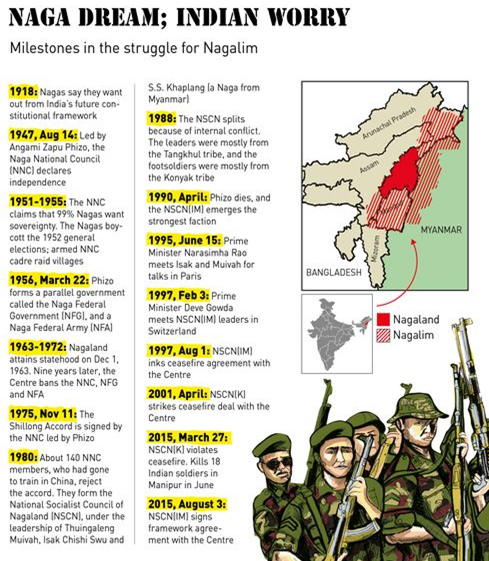In News: In the midst of revived efforts to resolve the "Naga political issue," the National Socialist Council of Nagaland or NSCN (I-M), stated that it would not accept the "Naga national flag" as a cultural flag, as suggested by New Delhi.
What’s in today’s article:
- History of the insurgency in Nagaland (Origin of the Naga tribes, post-independence scenario, when did the NSCN come into the picture)
- News Summary (The peace talks, recent developments)
History of the insurgency in Nagaland:
- Origin of the Naga tribes:
- The Naga tribes migrated from southwest China to Burma (now Myanmar) and Thailand before settling in North East India and North West Myanmar.
- The British coined the term Naga for administrative purposes to refer to a group of tribes with similar origins but distinct cultures, dialects and customs.
- The British adopted a way of governance over the Nagas that involved keeping their traditional ways of life, customs and laws in place while putting British administrators at the top.
- At present, the Naga tribes can be found in Nagaland, Arunachal Pradesh, Manipur and Myanmar.
- Post-independence scenario:
- With the withdrawal of the British, insecurity grew among the Naga tribes about their cultural autonomy after India’s independence.
- These gave rise to the formation of the Naga Hills District Tribal Council in 1945 (renamed as the Naga National Council (NNC) in 1946).
- A section of the NNC (led by Naga leader A.Z. Phizo) declared Naga independence on August 14, 1947, amid uncertainty about the Nagas' post-independence future.
- The Naga Federal Government (NFG, established in the early 1950s by Phizo) and its armed wing (the Naga Federal Army (NFA)) launched the underground insurgency.
- To suppress the insurgency, the Central Government sent armed forces into Naga areas and enacted the contentious Armed Forces Special Powers Act (AFSPA), which is still in effect in parts of Nagaland.
- Following the formation of Nagaland in 1963 and years of negotiations with the government, the NNC signed the Shillong Accord in 1975, agreeing to surrender arms and accept the Constitution.
- When did the NSCN come into the picture?
- The signing of the Shillong Accord was not agreeable among many top NNC leaders and those operating from Burma.
- Three NNC leaders - Thuingaleng Muivah of the Tangkhul Naga tribe of Manipur, Isak Chishi Swu of the Sema tribe and S S Khaplang from Myanmar’s Hemis tribe, formed the National Socialist Council of Nagaland (NSCN) to continue the armed movement.
- After years of infighting and violent clashes along tribal lines and, the NSCN split into two factions in 1988 - the NSCN-IM (led by Mr. Muivah and Swu) and the NSCN-K (led by Mr. Khaplang).
- The NSCN-IM demanded and continues to demand Greater Nagaland or Nagalim - to unite 1.2 million Nagas by including Naga-dominated areas in neighbouring Assam, Manipur and Arunachal Pradesh.
- The NSCN-IM became the most powerful insurgent group (after the death of Mr. Phizo in 1990), also playing a role in the creation of smaller groups in other states.
- Its armed operations intensified along with illegal activities like tax extortion, smuggling of weapons and so on.
News Summary:

- The peace talks:
- The Government of India persuaded the NSCN-IM to sign a ceasefire agreement in 1997 in order to begin talks with the goal of signing a Naga Peace Accord.
- Since the 1997 ceasefire with the NSCN-IM, there have been over a hundred rounds of talks between the Centre and the insurgent group, with no resolution in sight.
- New Delhi has been holding peace talks with the NSCN-IM and the Naga National Political Groups (NNPGs), which include the NSCN (K).
- Recent developments:
- In 2015, the Centre and the NSCN (I-M) signed the Framework Agreement, which was considered as the first step towards an actual Peace Accord.
- However, the peace process was stalled due to the outfit's insistence on a separate flag and a Naga constitution (Yehzabo) as part of the agreement.
- There have been reports that the Centre was open to using the Naga national flag for cultural purposes and incorporating a mutually acceptable part of the Naga constitution into the Indian Constitution.
- According to the Ministry of Home Affairs' (MHA) annual report, the NSCN-IM was involved in 44% of insurgency-related incidents in Nagaland in 2020.









